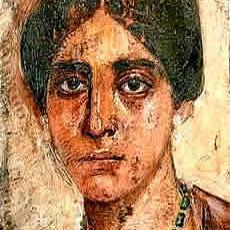Welcome to the one and only Saturday vote of Lent Madness 2021. After today, your weekends will be free from difficult and heart-wrenching electoral/sanctoral decisions. Today, though, it's Tarcisius vs. Egeria
Yesterday, Constantine dominated Miguel Pro 62% to 38% in a controversial matchup that left some voters abstaining, but every voter thinking, contemplating, and learning. Which is precisely the point!
Enjoy the Lord's Day tomorrow and we'll see you bright and early on Monday morning as we begin the first full week of Lent Madness 2021, with the Battle of the Greats as Leo the Great takes on Albert the Great. Thanks for joining us on this journey. We are truly grateful you've made Lent Madness part of your Lenten devotions this year.
Tarcisius
 Very little is known about the young boy martyr, Tarcisius. Our earliest reference to him comes from Pope Damasus in the late fourth century ce. In a poem honoring martyrs, Pope Damasus writes of Tarcisius, “When an insane gang pressed saintly Tarcisius, who was carrying the sacraments of Christ, to display them to the profane, he preferred to be killed and give up his life rather than betray to rabid dogs the heavenly body.” Tarcisius then, like Stephen, is a Christian witness who fell victim to mob violence.
Very little is known about the young boy martyr, Tarcisius. Our earliest reference to him comes from Pope Damasus in the late fourth century ce. In a poem honoring martyrs, Pope Damasus writes of Tarcisius, “When an insane gang pressed saintly Tarcisius, who was carrying the sacraments of Christ, to display them to the profane, he preferred to be killed and give up his life rather than betray to rabid dogs the heavenly body.” Tarcisius then, like Stephen, is a Christian witness who fell victim to mob violence.
Later stories fill in what might have transpired. According to those stories, during the reign of Valerian (253-259 ce), Tarcisius was a young altar server. Many Christians had been rounded up and put into jail for their belief. After the host had been consecrated in clandestine worship services, it was delivered to those who were imprisoned. Priests were easily recognized and targeted for harassment and arrest, so they would send others to deliver the consecrated host. One Sunday, young Tarcisius volunteered to deliver the eucharist to those in prison.
On his way to deliver the host, he passed a group of young friends who invited him to play a game. They were perplexed when he declined and began to jostle and tease him in good fun. They noticed he was clutching something to his chest, and they began to try to pry it from him. He knew the value of this treasure and the importance of his mission, and he held the host ever closer to his chest. The scrum, playful at first, grew more violent. In the tussle, one of the attackers saw a fish etched into the box holding the host. The playful abuse turned to violent assault as the boys began to pummel him for being a Christian.
A Roman soldier saw the disturbance and rushed over to rescue Tarcisius from the cruel gang. The Roman soldier revealed himself to be a Christian before little Tarcisius died in his arms. In some accounts, as he died, Tarcisius begged the soldier to finish his errand for him, and the soldier obliged. In other accounts, as he lay dying in the soldier’s arms, the host simply disappeared.
Tarcisius is the patron saint of altar servers and first communicants. His feast day is August 15.
Collect for Tarcisius
Almighty God, by whose grace and power your holy martyr Tarcisius triumphed over suffering and was faithful even to death: Grant us, who now remember him in thanksgiving, to be so faithful in our witness to you in this world, that we may receive with him the crown of life; through Jesus Christ our Lord, who lives and reigns with you and the Holy Spirit, one God, for ever and ever. Amen.
Egeria
 Egeria was a fourth-century woman who traveled to the Holy Land and wrote about her experiences, leaving the world an invaluable record of the development of language, liturgy, and Christianity.
Egeria was a fourth-century woman who traveled to the Holy Land and wrote about her experiences, leaving the world an invaluable record of the development of language, liturgy, and Christianity.
We don’t know all that much about Egeria, the person. From her writing, it would appear that she had some status—the ability to travel from Europe to Palestine in the late 300s was not common. We also know she was a woman of deep faith, in that she undertook such a journey.
Her extant writing consists of a lengthy letter, now in two fragments, that she sent back to her community in Europe. Scholars are divided as to whether this community was based in Spain or perhaps France. She addresses them as “her sisters,” which could signify a monastic community, but this was early enough that all Christians tended to address fellow believers with sibling nomenclature.
One fragment of her letter describes her approach from Mount Sinai to Constantinople, and the other fragment describes, in great detail, the liturgical practices of the church in Jerusalem and Galilee over a year. Egeria, it would seem, spent at least three years in Palestine, making notes and observations. This provides us with invaluable information about the liturgical life of the early church and how various reforms and ideas moved throughout the Christian world. Her letter, for example, gives us the first record of such familiar rituals as the Palm Sunday procession, the Easter Vigil, and the Good Friday remembrance.
Her letter also offers an important insight into the development of Romance languages. Because it’s written in a casual form of post-classical Latin, it forms a bridge between what was classical Latin and what would become the Romance languages. (In fact, Egeria’s letters feature some of the first known uses of the definite article.)
Egeria’s bravery and creativity enabled the entire Western world to access the liturgical life we now enjoy, as well as the language we use every day.
Collect for Egeria
Almighty God, whose will it is to be glorified in your saints and who raised up your servant Egeria to be a light in the world: Shine, we pray, in our hearts, that we also in our generation may show forth your praise, who called us out of darkness into your marvelous light; through Jesus Christ our Lord, who lives and reigns with you and the Holy Spirit, one God, now and for ever. Amen.
[poll id="303"]
198 comments on “Tarcisius vs. Egeria”
Not happy with “ce”.......Really??
Vote for Tarcisius. No matter his young age, he volunteered to risk his life taking the Elements to the prison, protecting them with his life, ultimately losing his life. Great was his belief.
Anyone who dies protecting the Eucharist has my voted hands down!
I had to vote for Tarcisius having been a life long acolyte.
The acolytes have a patron saint. Who knew? Seeing how this tournament is taking the place of our youth group/acolytes meeting in person, I have no choice but to vote for for Tarcisius!
Supreme Executive Committee:
Re "ce" for Common Era, I believe some of the confusion evinced in the comments may be because you didn't capitalize it. Professionally I'm an editor, and personally I read grammar and punctuation guides for fun, and I've never seen "ce" instead of "CE," just like I've never see "ad" instead of "AD" or "bc" instead of BC. Standard usage guides such as the Chicago Manual of Style, MLA Handbook, and Merriam-Webster Dictionary all use capitalization. AP (Associated Press) style still uses B.C. and A.D. exclusively, but even their style employs capitalization.
For all who are exercised over the lower-case "ce" in the bio above, I refer you to the print edition, "The Definitive Guide to Lent Madness: Saintly Scorecard 2021," page 48. You will discover that CE is indeed capitalized but in a smaller font. This is true as well for Constantine, p 29; Evagrius the Solitary, p 33; Matthias, p 43; Nino of Georgia, p 46; and Theodora the Empress, p 50. I suspect that in being ported from the text version (the slugs of type being carefully, prayerfully, and accurately positioned on the lead sticks by monks devoted exclusively to the printing press and to preserving the secrecy of the recipe to their centuries-old liqueur) to the creaking html platform of WordPress, whose wondrous quirks (i.e. irritating deficiencies--such as no "like" button) are by now familiar to us, the font distinctions are lost, reducing CE to a generic lower-case ce. Good scholars always consult the original text. And good Christians reserve their rancor for the kitsch round, at which you can KRANK it up for the bobble-head, glow-in-the-dark, dashboard saints; or better yet, call out the grifting false prophets who preach passivity to power and pass the plate in maskless churches, fleecing their flock even as they place those little ones at risk of illness and death.
[…] Today’s Contenders: […]
As an acolyte and chalice bearer, I lean toward Tarcisius, and am glad we have a patron saint!
However Egeria gets my vote as a gutsy woman travelling in a dangerous time, and the wonderful letters she wrote that are such a valuable source on the early church.